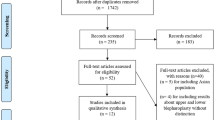Abstract
Background
Double eyelid blepharoplasty is a popular procedure among Asian population. Double eyelid shape is important to achieving high satisfaction rate. Currently, there lacks large sample survey and detailed analysis on preferred double eyelid shape. This study aims to investigate the double eyelid shape preference using the “in-fold,” “on-fold,” and “out-fold” classification and analyze the preferred shape of different demographic groups.
Methods
A large sample survey was conducted with a questionnaire of nine questions in three sections: demographic characteristics, desired double eyelid shape, and assessment of the classification. The preference for each type of double eyelid shape was analyzed and compared among different groups.
Results
A total of 11153 (9698 female and 1455 male) respondents finished the questionnaire, including 382 plastic surgeons. In-fold double eyelid was the most popular choice overall. Out-fold was the least preferred, except for specific groups such as actors and heavy makeup wearers. No significant difference was observed between the preference of patients and plastic surgeons. The majority of respondents cared much about postoperative double eyelid shape and considered the classification useful.
Conclusions
In-fold was the most preferred double eyelid shape, especially for patients who met one or more of the following criteria: male, older than 40, divorced, or housewives. However, heavy makeup wearers or actors/actresses tend to prefer out-fold double eyelids. The “in-fold,” “on-fold,” and “out-fold” classification was precise and beneficial to doctor–patient communication.
Level of Evidence V
This journal requires that authors assign a level of evidence to each article. For a full description of these Evidence-Based Medicine ratings, please refer to the Table of Contents or the online Instructions to Authors www.springer.com/00266.







Similar content being viewed by others
References
Burusapat C, Thanapurirat S, Wanichjaroen N, Pruksapong C, Attainsee A, Jankajorn S (2020) Anthropometry analysis of beautiful upper eyelids in oriental: new eyelid crease ratio and clinical application. Aesthetic Plast Surg 44(2):392–410. https://doi.org/10.1007/s00266-019-01536-w
Hwang HS, Spiegel JH (2014) The effect of “single” vs “double” eyelids on the perceived attractiveness of Chinese women. Aesthet Surg J 34(3):374–382. https://doi.org/10.1177/1090820x14523020
Paik JS, Lee JH, Uppal S, Choi WC (2020) intricacies of Upper blepharoplasty in Asian burden Lids. Facial Plast Surg 36(5):563–574. https://doi.org/10.1055/s-0040-1718391
Wang HC, Ting W, Tong D, Dong R, Long X, Huang J, Cao H, Tianyu Sun E, Yu N, Wang X, Zhao R (2021) Will the patient’s double eyelid shape be like that of the surgeon performing the procedure? A study of surgeons’ aesthetics in East Asian Blepharoplasty. J Cosmet Dermatol 20(4):1208–1213. https://doi.org/10.1111/jocd.13699
Chen SN, Chen SH, Chen CC, Huang CL, Tai HC, Wang YP (2017) Chen’s double eyelid fold illusion: an eye size assimilation illusion induced by a supratarsal fold in the brow-eye unit, A preliminary report. Aesthetic Plast Surg 41(6):1375–1381. https://doi.org/10.1007/s00266-017-0961-5
Suo L, Li J, Fu R, Xie Y, Huang RL (2020) A four-step technique for creating individual double-eyelid crease shapes: a free-style design. Plast Reconstr Surg 146(4):756–765. https://doi.org/10.1097/prs.0000000000007185
Chen WP (2020) The eyelid crease height, depth, and shape: a scoring system for revisional asian blepharoplasty. Plast Reconstr Surg Glob Open 8(5):e2802. https://doi.org/10.1097/gox.0000000000002802
Wang C, Mei X, Pu LLQ (2021) Asian upper blepharoplasty in women: a comprehensive approach for a natural and aesthetically pleasing outcome. Aesthet Surg J. https://doi.org/10.1093/asj/sjab021
Wang G, Zhang S, Ma J, Li D, Xue H (2018) Cosmetic and structural outcomes of two different techniques of medial epicanthoplasty according to epicanthal fold classification and severity: a cohort study. J Plast Reconstr Aesthet Surg 71(10):1453–1461. https://doi.org/10.1016/j.bjps.2018.05.042
Gaofeng L, Jun T, Zihan W, Wei D, Huawei O, Fan Z, Mingcan L (2015) Therapeutic strategy for different types of epicanthus Zhonghua Zheng Xing Wai Ke Za Zhi. Chin J Plast Surg 31(6):428–431
Rhee SC, Woo KS, Kwon B (2012) Biometric study of eyelid shape and dimensions of different races with references to beauty. Aesthetic Plast Surg 36(5):1236–1245. https://doi.org/10.1007/s00266-012-9937-7
Author information
Authors and Affiliations
Corresponding authors
Ethics declarations
Conflict of interest
The authors declare that they do not have any conflicts of interest.
Additional information
Publisher's Note
Springer Nature remains neutral with regard to jurisdictional claims in published maps and institutional affiliations.
Rights and permissions
About this article
Cite this article
Li, Z., Zhang, S., Yu, J. et al. Double Eyelid Shape Preference: A Large Sample Survey. Aesth Plast Surg 46, 2287–2294 (2022). https://doi.org/10.1007/s00266-022-02880-0
Received:
Accepted:
Published:
Issue Date:
DOI: https://doi.org/10.1007/s00266-022-02880-0




